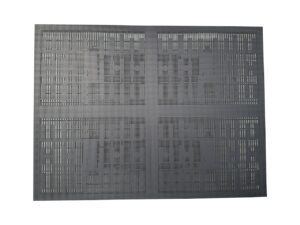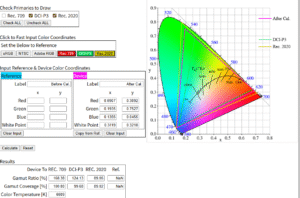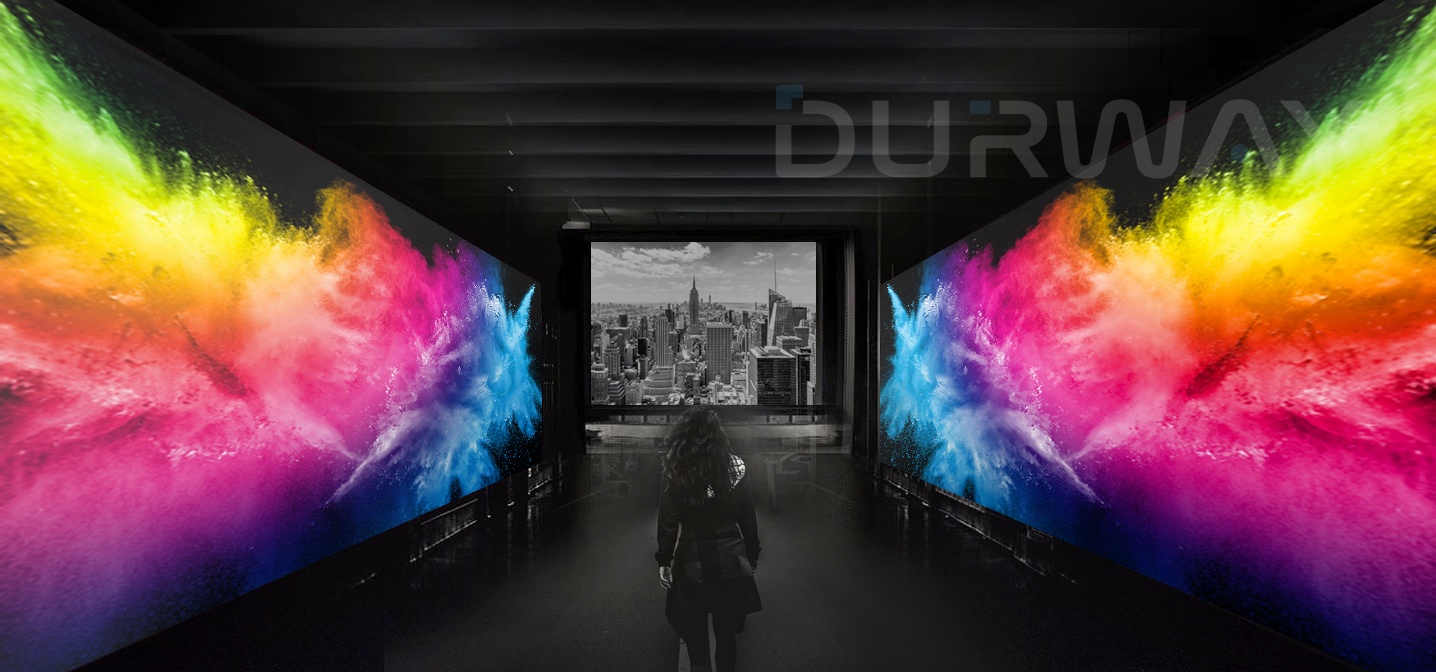1, Where Visuals Meet Sound- Acoustic LED screen
In the world of immersive display technology, the synchronization of visuals and audio is not just a luxury — it is essential for delivering a convincing and memorable experience. Whether in a cinema, a planetarium, or a virtual production studio, the human brain instinctively expects sound to come from the exact location of the visual source.
Traditional LED screens, while visually stunning, often force designers to compromise on this principle. Speakers must be mounted to the sides, above, or below the screen. This creates an unnatural disconnect, where the eyes see one thing and the ears hear from another direction. Over time, this mismatch can reduce immersion, cause listener fatigue, and make the content feel less “real.”
The Acoustic LED Screen solves this problem elegantly. Designed with precision-engineered gaps in its LED module structure, it allows sound to pass directly through the display surface with minimal distortion. This enables loudspeakers to be placed exactly where the visuals appear, creating a unified sensory experience. In this way, sight and sound merge into one cohesive performance — essential for high-end venues that demand the best.

2. What is an Acoustic LED Screen?
An Acoustic LED Screen — also called an acoustic transparent LED display or sound-permeable LED screen — is a specialized fine-pitch LED display designed to maintain exceptional image quality while allowing audio to pass through the screen surface.
This is achieved by rethinking the very structure of the LED module and printed circuit board (PCB). Instead of a solid, fully covered surface, the module incorporates:
Open-area patterns that allow air and sound to flow freely.
Micro-perforations in the PCB and mask design.
Strategic LED placement that optimizes both pixel density and sound transparency.
Typical specifications include:
Pixel Pitch: 1.5mm, 1.9mm, and 2.5mm models are most common, balancing high resolution with optimal acoustic transparency.
Transparency Rate (ATR): Acoustic Transparency Ratio can range from 5% to 10%, depending on pitch and design.
Brightness: 600 nits for indoor applications.
Color Accuracy: Calibration to achieve ≥97% DCI-P3 or >86% REC 2020 coverage for true-to-life colors.

This combination makes the Acoustic LED Screen an ideal solution where both image fidelity and accurate sound reproduction are critical.
3, How Acoustic Transparency Works
To understand why this technology is unique, let’s break down the science:
The Acoustic Transparency Ratio (ATR) measures how much of the screen’s surface is physically open for sound to pass through.
ATR Formula: ATR = (Open Area / Total Screen Area) × 100%
In practice:
Low frequencies (bass) have longer wavelengths and pass through easily, even with lower ATR values.
Mid frequencies (speech range, 500–2000 Hz) require careful design to avoid muffling.
High frequencies (treble, >5 kHz) are most affected by obstruction but can be corrected with digital equalization.
Engineering Considerations:
Pixel Pitch Impact: Smaller pitches (<1.5mm) increase visual resolution but reduce ATR, requiring advanced acoustic compensation.
Screen Surface: Non-reflective, acoustically neutral materials are preferred to avoid altering sound tone.
Speaker Alignment: Placing speakers directly behind visual elements ensures precise localization — a person will experience original sound with visualization.
4, Key Advantages of Acoustic LED Screens
4.1 Seamless Audio-Visual Integration
Sound comes from the exact visual source, improving realism and reducing cognitive dissonance for viewers. This is vital for storytelling, education, and interactive experiences.
4.2 Space Efficiency
No need for bulky side or overhead speaker arrays. The speaker system sits directly behind the display, freeing valuable space for seating, set design, or equipment.
4.3 Enhanced Immersion
Whether simulating a starfield in a planetarium or placing an actor into a virtual set, the removal of audio-visual disconnect makes the content more believable and engaging.
4.4 High Performance in Both Domains
Brightness, color accuracy, and refresh rates remain on par with non-acoustic LED screens, while acoustic performance remains within ±2 dB of open-air speaker placement.
4.5 Flexible Maintenance
Front and rear access designs ensure minimal downtime. In many installations, entire LED modules can be swapped without disturbing the speaker layout behind them.
4.6 Remote Power System for Safety and Reliability
Moving power supplies to a separate control room:
Reduces heat buildup and noise near the audience.
Improves safety by keeping high-voltage equipment out of public reach.
Simplifies maintenance — technicians service power units without accessing the display structure.
Extends LED lifespan by maintaining a controlled environment.
The second power supply system ensures the signal transmission is more stable.

4.7 Acoustic Design Flexibility
Modules can be arranged in flat, curved, or dome geometries without compromising sound quality, enabling unique immersive space experience.
5, Application Scenarios
5.1 Theaters
Dolby Atmos-enabled theaters benefit from direct sound projection through the screen, matching the director’s intent for sound placement. Explosions feel as if they occur on screen; dialogue is crystal clear.
5.2 Planetariums & Astronomy
In a dome, sound misalignment can break immersion quickly. Acoustic LED domes ensure narration, ambient effects, and music all emanate from the correct visual location — whether it’s Saturn’s rings or a distant galaxy.
5.3 Museums & Science Centers
Interactive exhibits become more engaging when visitors can both see and hear from the same focal point, without visible speakers disrupting the design.
5.4 Virtual Production & XR Studios
In XR stages, sound monitoring and live audio capture can happen directly in front of the LED wall without interference, improving workflow for directors and sound engineers.
5.5 Sports Arenas & Event Halls
Large scoreboards or stage backdrops can deliver both visuals and announcer commentary from a single integrated surface.
5.6 Simulation & Training Systems
Flight simulators, driving simulators, and defense training platforms use audio cues for split-second decision-making. Perfect sound localization improves reaction time and realism.

6, Case Study – Lowell Astronomy Theater
The Lowell Astronomy Theater installation is a benchmark in dome-based immersive environments.
Project Specs:
Type: Acoustic LED Display
Pixel Pitch: 1.9mm
Length: 30 meters x 7m
Resolution: 61K equivalent
Brightness: 350 nits
Sound System: Multi-channel surround, mounted directly behind display surface
Power System: Fully remote, in a climate-controlled control room
Why Acoustic LED?
The theater required both an uninterrupted dome surface and pinpoint-accurate sound localization. Conventional projection systems could not achieve the same brightness or allow rear-mounted speakers without visible obstruction.
Results:
Visitors experience celestial events as if they were floating in space. Narration aligns perfectly with visual elements, and immersive soundscapes envelop the audience without visible hardware.
7, Acoustic LED Screens vs. Traditional LED Screens
| Feature | Traditional LED Screen | Acoustic LED Screen |
| Sound Source Position | Off-screen | Directly behind the screen |
| Audio-Visual Sync | Indirect | Perfect alignment |
| Space Usage | Requires speaker space | Space-efficient |
| Immersion Level | Good | Exceptional |
| Maintenance Access | Varies | Front & rear |
| Power Supply Location | In frame | Remote control room |
| Design Flexibility | Flat only | Flat, curved, or dome |
8, Future Trends & Market Outlook
According to industry reports, the global immersive display market is expected to grow at a CAGR of over 20% through 2030, with acoustic LED solutions gaining traction in:
High-end entertainment (cinemas, themed attractions)
Education & research (immersive lecture halls, digital classrooms)
Corporate (brand experience centers, product launch events)
Metaverse infrastructure (mixed-reality spaces requiring true audio-visual integration)
Emerging technologies like sub-1.2mm acoustic LEDs and integration with AI-driven spatial audio promise even greater realism.
9, Conclusion & Call-to-Action
The Acoustic LED Screen is not simply an upgrade to traditional LED technology — it is a paradigm shift in immersive design. By uniting sight and sound in a single surface, it delivers experiences that are richer, more convincing, and more memorable.
From the Lowell Astronomy Theater’s breathtaking video wall to advanced XR stages, this technology proves that the most powerful stories are both seen and heard in perfect harmony.
Durway specializes in fine pitch acoustic LED screens for theme parks, theaters, planetariums, and museums, etc. If you want to know more information, please click below:
https://durway.com/acoustic-led-screen/
Interested in transforming your venue? Contact us today to explore how our acoustic LED solutions can make it happen.








